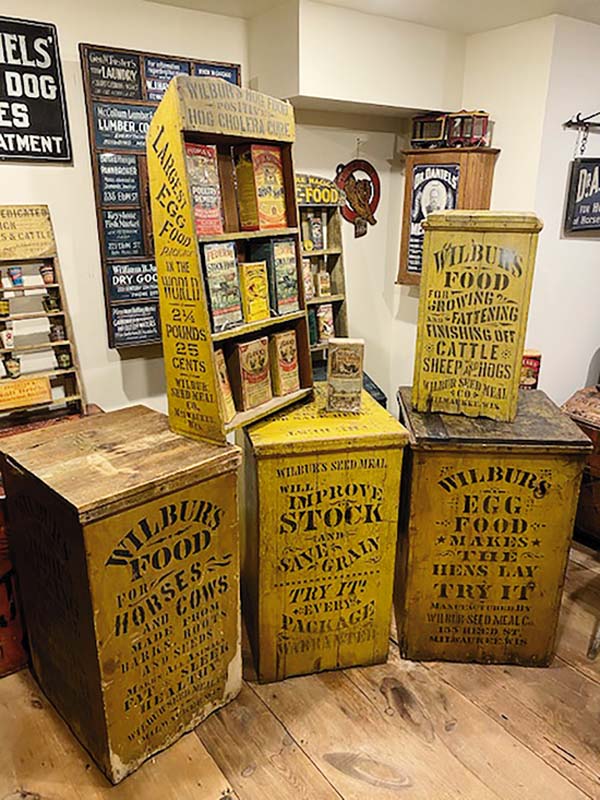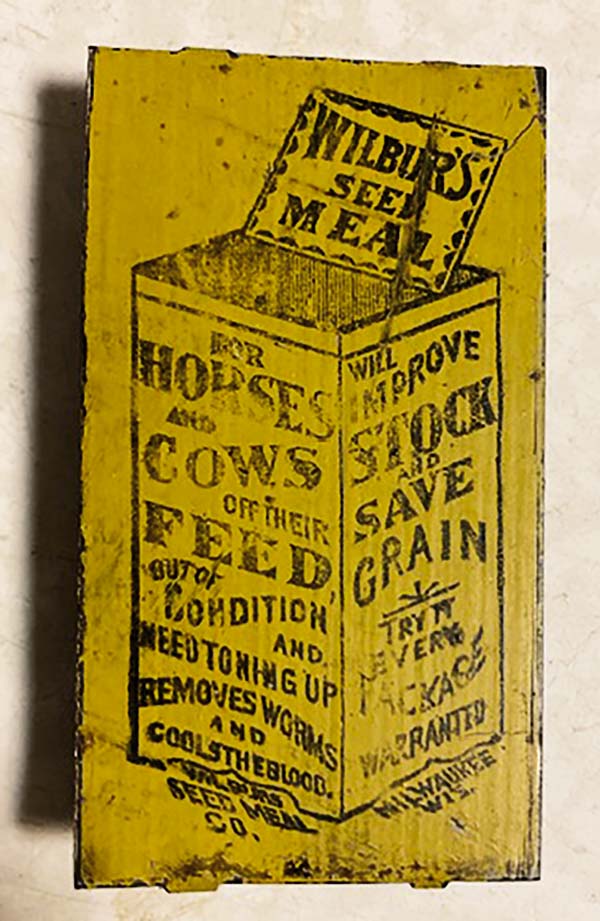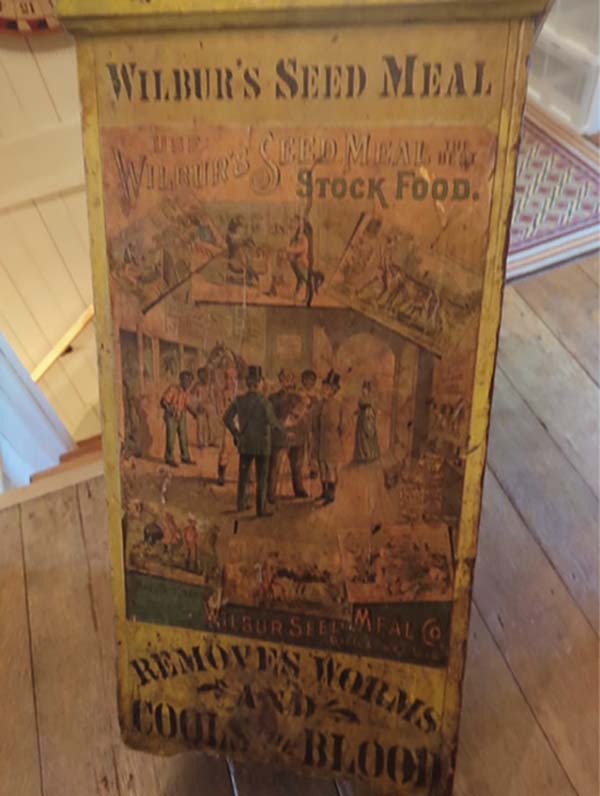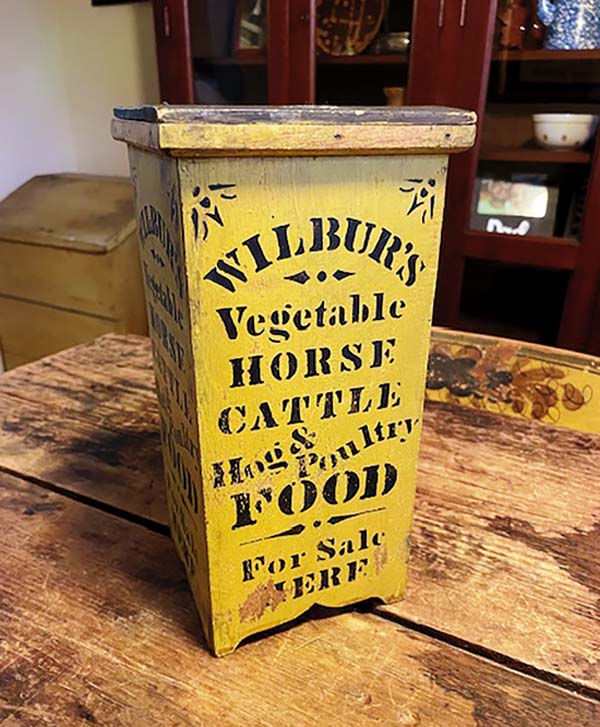Wilburs Vet A Brief History Of Antique Advertising Bins From The Wilber Stock Food/Seed Meal Company
By Andy Kmiec - January 24, 2025
Recently, I was asked to look at photos of a Wilburs wood stock food bin by a collector and offer some insight. It was during that conversation the person mentioned there isnt any information available online regarding Wilburs and the bins/cabinets/racks that they made to display their products. I am a longtime collector of antique veterinary advertising, especially wooden cabinets, display racks, and stock food bins. I wrote this short history on the topic with the help of several collector friends. The Wilbur Seed Meal Company opened in Milwaukee, Wis., in the 1890s. They sold Stock Food which was purported to have medicinal value for farmers livestock. They also produced a line of veterinary patent medicines. In 1900, the company changed their name to the Wilbur Stock Food Company. Before I get to the bins, a quick nod needs to be given to the other two ways Wilburs advertised and sold their product in general stores and feed stores. The glass front cabinet, with stenciled advertising on the door and paper labels on each side, was meant to display small tins and smaller packages of product. Ive seen a few of these cabinets in private collections. The wooden rack is larger than the typical Blackmans or Magic Food stands that were made by competing companies. The stenciling on the sides and mustard base paint is common for all the racks Ive seen. The stenciling on the marquee varies. The example pictured is the only one Ive seen listing a specific cure on the top stencil while other examples have more generic advertising for Wilburs Stock Food. Now to the bins. Please keep in mind that these bins are all made of what was then cheap materials such as pine, tongue and groove boards and round nails. Yellow paint was used for the base color and black paint for the stencils. Since they were made by factory workers and not machine cut and assembled, there are variations to the sizes; however, the construction technique is consistent throughout. These bins were meant to hold loose product that would be scooped out in the store by the customer and sold by the pound. The loose product was then placed in Wilburs buckets or feed bags. Pictured is an exceedingly rare tin tag with an image of the bin used to secure the opening of a cloth or paper bag. This acted like a tin tobacco tag with triangular shaped push points. The bins fall into three general sizes. The largest and most common typically measure in the range of 30 to 36 inches high, 16 to 20 inches wide and 16.5 to 23 inches deep. The molding that is under the lid is a standard technique and the boards were cut at the base to create a stylish foot. The bins were never painted inside, and the lids themselves would have been stenciled with advertising on the exterior, Inside you might still find a price sheet. The bins would have been shipped via the railroad to their destination with the top nailed shut. As a result, every bin Ive seen that still retains their original lid has one board that remains nailed down at the top and the other boards secured together with strips of wood underneath allowing the lid to slide on and off. I do have one large bin with the lid having hinges. The stenciling on the bins will differ with some early versions including the words Reed Street, noting the location of the factory in Milwaukee. Some bins were trimmed at the bottom by store owners to reduce the height to facilitate the removal of product from the bottom of the bin. Ive owned a number of these larger Wilbur bins over the years and have seen close to 35 examples. The rarest variation of these large bins are examples with paper labels. These bins have one side that is stenciled like a typical bin and have paper posters that have been glued down on the other three sides. Stenciling can be found above and/or below each poster. Ive owned one of these and have had the pleasure of seeing three others in collections. The bin pictured is in a private collection. These seem to be rare, and hopefully this article will bring other examples to light. The medium size bin is uncommon and more difficult to find. Ive owned three and have seen several more in private collections. Like their big brother, they are constructed the exact same way with tongue and groove boards, painted yellow with black stenciling. There is molding around the lid and the feet are shaped in the same manner. One unusual difference with these bins is the addition of a price and/or product sheet on the inside of the lid. In addition to the typical stenciling on the exterior of the lid, you will also see the words, The Best, stenciled across the top board. As noted, these bins are not painted on the inside and are not painted on the underside of the lid. The medium bins measure in the range of 24 to 26 inches in height, 13 to 15 inches wide, and 14 to 16 inches deep. There are variations to what youll find with the stenciling on the side. One uncommon variation has one side stencil done on an angle. The third size bin is incredibly rare. One was recently sold by Bill Morford and is currently in a private collection. It measures 10 1/8 high, 5.25 inches wide and 5 inches deep. The lid has been replaced. This bin also has the trim around the lid and the same shaped foot as the larger versions. I would have thought this might have been a salesmans sample if I hadnt experienced seeing an even smaller example years ago. It turned up at an auction in the Midwest back in the 1990s, purchased by a Midwest dealer and later owned by another dealer in Pennsylvania where I saw it. Sadly, the price was beyond what I could afford at the time, and it didnt come home with me. The size of that example is roughly 6 inches tall, 3 inches wide and 3 inches deep. It also had a replaced lid, painted yellow. I would consider it to be an example of a salesmans sample. Many thanks to the collectors who provided me with photos of their bins. I know there are variations that are out there in collections that arent known to me. It is my hope to learn more and see additional examples. If youd like to share, my email is amkmiec@mail.com. Im sure the workers who made these bins would be amazed to see that so many have survived the test of time and are valued and collected today.





SHARE
PRINT